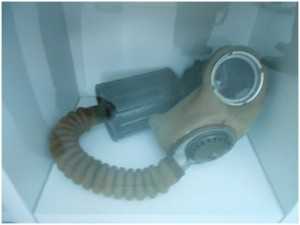SS Lochgarry
The first time I dived the wreck of the SS Lochgarry it was a hot day in June and I was sweating in my dry suit as I waited for the skipper to give us the signal to roll in. There were six of us were diving the wreck. I was last in when we finally got the signal to go. You could still feel the run of the tide as I swam to the shot. By the time I reached the line the buoy was under water with the weight of the tide coupled with the weight of five divers already holding on to it. I had been told previously about the strong currents that surround the wreck and I was getting first-hand experience of the same. I descended down the line and got my first glimpse of the SS Lochgarry.
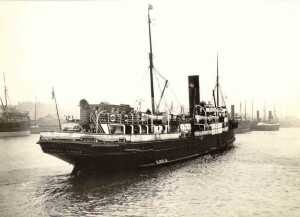
Lairdsrock Leaving Broomielaw(3)
The start of the story of the SS Lochgarry:
G and J Burns Ltd(1)
George and James Burns were produce merchants. They became involved in shipping around 1824. The routes between Glasgow to Ayr and Belfast to Liverpool were prominent routes for the company for many years.
There is a famous story that in 1829, George Burns wanted his first steam ship called the GLASGOW to sail on the Liverpool service on a Saturday. This meant that the ship would be at sea on a Sunday. In order to achieve his wish Burns had a Chaplin accompany her en-route.
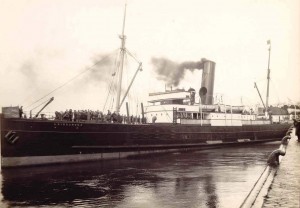
Lairdsrock at Customs House Quay in Greenock(3)
SS Vulture
In the late 1890s G and J Burns Ltd ordered two steam ships to be built by A&J Inglis. A&J Inglis were shipbuilders founded in 1862 after the acquisition of a shipyard at Pointhouse, Glasgow. The firm built more than 500 ships in just over 100 years including many famous ones, such as the paddle steamer “Maid of the Loch” which is now a visitor attraction on Loch Lomond.
The two steam-ships ordered by G and J Burns Ltd were launched in 1898, and when completed were 1280gt and 265 feet long. The ships were christened “Magpie” and “Vulture”. Some unusual design features of the time were that Magpie and Vulture’s passenger accommodation was placed amidships and a dining saloon was located in a deckhouse on the poop. Another unusual feature was that both ships were given fidded masts. This allowed the top mast to be lowered in the event that either ship needed to navigate the Manchester Canal.
Vulture was used mainly on the Glasgow to Belfast and Ardrossan to Belfast routes for much of her career, eventually being replaced. During the First World War Vulturewas taken off her normal routes and used on the Aberdeen to Bergen route.
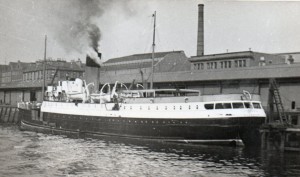
SS Lochgarry at Lancefield Quay Glasgow(3)
SS Lairdsrock
In 1922 G and J Burns Ltd amalgamated with Laird Lines to form the company Burns and Laird Lines Ltd. G and J Burns Ltd at this time brought 15 ships into the new company one of which was Vulture. By 1924 Vulture was over 25 years old and due for a refit. She was upgraded by the Scottish ship builders D and W Henderson who at the time were under the management of Harland and Wolff. They fitted new boilers and modified her accommodation. In May of 1929 all 15 ships in the Burns and Laird Fleet were renamed. As part of the rename all ships were given the prefix Lairds-. The Vulture was renamed the SS Lairdsrock. It is believed that between the end of the First World War and 1936 that Vulture/Lairdsrock continued to sail between Ardrossan and Belfast.

SS Lochgarry brochure for Highland Cruises from the late 1930s (4)
SS Lochgarry
In 1936 Burns and Laird Lines Ltd took delivery of the two modern motor ferries, the Royal Scotsman and the Royal Ulsterman. The Ardrossan to Belfast night sailings were discontinued and the Lairdsrock became redundant. The Lairdsrock was chartered and eventually sold to David MacBrayne Ltd who renamed her SS Lochgarry in 1937. She became the largest member of the David MacBrayne Ltd fleet.
The Lochgarry was extensively refitted with new accommodation and a new funnel, before becoming a West Highland Cruiser. She cruised around scenic parts of the west coast of Scotland including: The Arran and Islay islands; Durat Castle; Lochness; Oban; and Tober Moray as well as offering views of some of the tallest Munros.
World War Two(4)
On the 24th of April 1940 the Lochgarry was requisitioned by the government. She had been laid up at the time of requisitioning possibly due to not being used as a cruise ship during the winter months. She sailed to the south to England where she was chartered as a troop ship bringing troops to and from France. She took part in Operation Dynamo, the evacuation of British and French troops from the beaches of Dunkirk during the period May to June 1940. Shortly after departing from Dunkirk on the 29th of May she was attacked and damaged by enemy bombs which also holed her Royal Navy escort. Despite this she returned to England safely with over 1000 troops on board. From England the Lochgarry returned to Scotland and was released from Admiralty work on the 12th of June 1940. She entered dry dock for repairs at Ardrossan in mid-June and then returned to Greenock in late June where she remained laid up for the rest of the year. She operated under charter for the Admiralty for a total of 50 days. The Admiralty paid £3,091 for her 50 day charter. The insurance recovered was £50. Her costs for the same period were £5,575 which incurred a total loss of £2,446. In January 1941 she began a second charter for the Ministry of War Transport which required her to sail between Douglas, Ramsey, Barrow in Furness and Liverpool. She then sailed to Reykjavik in Iceland before returning to England. After this the Lochgarry was employed as a troop ship and made several trips between Leith and Torshavn in the Faroe Islands surviving another air attack on the 17th of September. The rest of 1941 saw her sailing between Oban and Torshavn and surviving yet another air attack on Christmas day of that year.
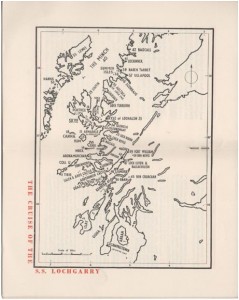
Page from Cruise Brochure showing the sights(4)
Final Voyage (5) (6)
Departing from Torshavn on 1st of January 1942 the Lochgarry sailed to Glasgow via Oban. She left Glasgow on the afternoon of the 20th of January for Oban to pick up a group of Soldiers bound for the Faroe Islands. She was in ballast with a crew of 49 hands and one passenger. As the evening wore on the weather turned, the wind increased to a moderate gale and visibility was poor with periods of rain and snow. At 10:15am that evening a course was set for the Mull of Kintyre, the weather remained poor with gale force winds and limited visibility. The ship continued at full speed and the Mull of Kintyre light was expected to be seen around midnight. No light was spotted and at 12:25am the Lochgarry struck rocks. The master thought that this was the Mull of Kintyre but it turned out to be the rocks off Torr point. The master ordered the engines full astern and the Lochgarry refloated herself at 12:35am. The engines were then reduced to slow astern and her stern turned into the wind. The master ordered some of the crew to shore up the watertight bulkhead in the forward hold, whilst others were ordered to make lifeboats ready to abandon ship.
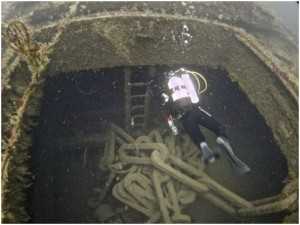
Diver entering the forward hold, the chain placed by the Royal Navy is clearly visible (7)
Distress rockets were sent out at intervals. An SOS was sent out and a reply received. Unfortunately as the master had believed their position to be the Mull of Kintyre incorrect information was sent regarding the ships position and the rescue tug never appeared. Around 2:40am a signal lamp was spotted on the shore flashing the letter U. The signal represented the fact that the ship was running into danger. The master turned the bow into the wind and the Lochgarrybegan to take on water rapidly and the order to abandon ship was given between 3 and 4am. The two after lifeboats were lowered and the crew made their way away from the ship. The master and chief engineer stayed on board until 5:30am when they then left the vessel in another lifeboat. The Master and Chief Engineer arrived on Rathlin Island around 6:30am. They found 25 of the ship’s crew there, however 23 of the crew were missing. It eventually transpired that the lifeboat containing the 23 missing crew members had been swept north and struck the only offshore rock on Rathlin Island’s east side. The life boat capsized drowning some of its occupants. The crew members that made it ashore, subsequently died as a result of exposure and injuries they suffered on hitting the rocks whilst trying to reach shore. The Rathlin coast guide organised search parties after seeing the distress rockets. All survivors were accounted for by the morning of the 21st of January.
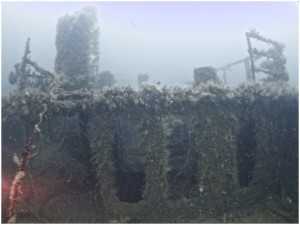 View facing forecastle accommodation(7)
View facing forecastle accommodation(7)A board of Inquiry to investigate the sinking of the Lochgarry was conducted in the County Building in Glasgow between the 1st and 4th of September 1942. At the end of the inquiry the court found that “The loss was probably due to an abnormal set towards the Irish coast owing to a moderate SE gale, occurring during darkness and in poor visibility owing to frequent snow and rain squalls, but was also contributed to by the default of the master.”(5)
It was recommended by the court that the master’s certificate “should not be dealt with”(5) that is taken from him but he should be severely reprimanded due to his failure to sight the Mull of Kintyre. Failure to sight the Mull of Kintyre should have caused the Master to take precautionary measures.
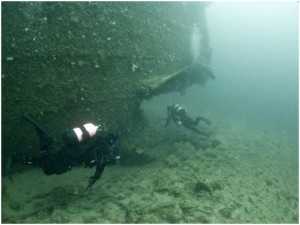 Divers at the Bow. Note the damage caused by the grounding of the bow (7)
Divers at the Bow. Note the damage caused by the grounding of the bow (7)The Wreck
The wreck today sits upright on the sea bed off the Coast of Rathlin Island in approximately 32 meters. It is largely intact though the stern section has started to collapse. The wreck is usually buoyed, when I last dived the wreck the shot was attached to the port railings around midships.
There are several recognisable features on the wreck. Some wood decking plates have survived and there are several bollards still in place. One of the most discernible features is the black and white tiles on the deck. This was once a bathroom floor, the walls and ceiling have rotted away to revel the tiles, some pieces of porcelain from toilets and sinks can be seen nearby. The engine room is open and the triple expansion engine is exposed. Coming forward on the wreck it is possible to see into the forward Hold, the width of the hold is covered with heavy chain placed there by the Royal Navy in an attempt to stop anyone obtaining the rifles, grenades and munitions stored in the hold.
The Lochgarry is one of the most popular recreational wrecks in Ireland. It rests in a very tidal area and should only be dived at slack tide. At the height of the dive season it is usual for the site to be extremely busy. On a recent dive Dr. E. Bourke, diver and Shipwreck Historian, recovered a gasmask hose that would have been carried by one of the many soldiers that the Lochgarry transported.
Notes:
1/ The historical archives held by Caledonian and MacBrayne show that in the MacBrayne Board Minutes of 29th Sep 1942 that the book value of the vessel was £36,386/10/7d and the insured value was £50,000. The amount received from the underwriters made for a profit of £16,676/12/10d over the book value.
References
- (1):^ Colin Campbell and Roy Fenton (1999) Burns and Laird
- (2):^ A. & J.Inglis (http://en.wikipedia.org/wiki/A._&_J._Inglis) Accessed 02 Aug 2012
- (3):^ ^ ^ Colin Campbell and the Burns and Laird Archives
- (4):^ ^ ^ Ian McCrorie and the Caledonian MacBrayne Archives
- (5):^ ^ ^ Report of Court No. 7936
- (6):^ Tommy Cecil (1990) The Harsh Winds of Rathlin
- (7):^ ^ ^ Damian Joyce
Copyright in all underwater photographs in this article resides with Mr Damian Joyce.
Special Thanks to Dr Edward Bourke, Damian Joyce, Colin Campbell, Ian McCroie and Mick O’Rourke for all their help and advice.
